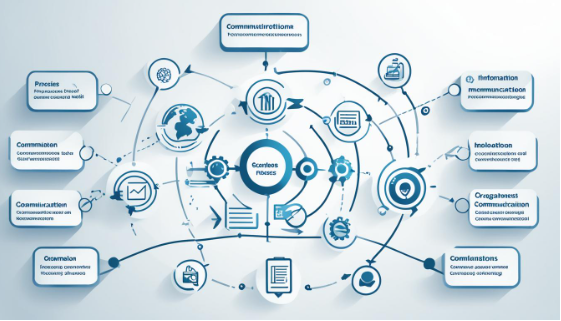In today’s world, managing and sharing knowledge well is key for business success. Businesses aim to boost productivity and innovation. This makes the link between Knowledge Management (KM) and intranets more important than ever. Here, we’ll dive into KM’s details, intranets’ roles, and why combining them can lead to success.
Knowledge is crucial for all businesses. When managed well, it opens many doors. Learning about different types of knowledge helps organizations work better. This drives better decisions and a culture that values learning and creativity.
Intranets are like the digital core of companies, making smooth communication and information sharing possible. When you connect KM and intranets, something amazing happens. It boosts how productive and engaged employees are, which lifts the whole company’s performance.
Our guide will show the benefits of linking intranets with KM. We’ll talk about how it boosts decision-making, sharing knowledge, and teamwork. We’ll also look at the hurdles companies can face when setting up KM systems. And, we’ll share ways to overcome these challenges. This will help companies get the most from their knowledge resources.
Understanding Knowledge Management (KM)
What is Knowledge Management (KM)? Knowledge Management (KM) is about how businesses handle knowledge and information. It includes collecting, processing, sharing, and using knowledge. Key parts of KM are creating and capturing knowledge, sharing it, using it, and storing it.
The start of “Knowledge Management” as a term was at McKinsey in 1987. It came during an internal look at how they handle information. KM first got attention at a 1993 conference in Boston by Ernst and Young. There, IBM showed a map for their KM consultants. This map outlined the working parts of KM.
Good KM does a lot for companies. It makes them work better, helps in making decisions, boosts innovation, and grows their people. The goal of KM is to create a culture where people share freely and can easily find information. This mimics the setting where successful ideas in research are born, open and full of learning.
There are several types of knowledge: explicit, tacit, implicit, and embedded. Explicit knowledge is facts in books, databases, and papers. It’s easy to share. Tacit knowledge is hard to write down. It’s the insight and experience in people’s minds.
Knowledge management tools show helpful info through FAQs, webinars, and others. Companies use systems like Bloomfire, Document360, and Zendesk Guide to share knowledge. These help employees learn and grow through training and stories.
Key Components of Knowledge Management
Effective knowledge management (KM) relies on key parts that form its core. These elements help create, capture, share, and use valuable info. They also ensure this knowledge is available where and when it’s needed.
Knowledge creation and capture start the process. It means coming up with new ideas, documenting them, and making them easy to find. Creating a culture that supports new thinking and sharing these ideas widely is very important here.
Then, knowledge sharing and dissemination step in. This part makes sure everyone in the organization can reach the info they need. It involves using tools for collaboration, training people, and setting up ways to share knowledge.
The third step is knowledge utilization. It’s about putting what the organization knows into action. This can make the company work better and smarter. It improves how work is done and choices are made by using the best knowledge available.
Finally, there’s knowledge storage and retrieval. This part is key for keeping info organized and easy to get to. It saves time for employees who can quickly find what they need. This means work is done faster and more efficiently.
Working on these components helps organizations create a strong knowledge management system. This system leads to better teamwork, new ideas, and always getting better at what you do. Making these parts a big part of how you work is crucial. It helps make the most of knowledge as a key advantage.
What is an Intranet?
An intranet is like a secure internet for a company’s workers only. It uses the same technology and connections as the internet but is private. Employees can share info, manage documents, and access important company data via the intranet. It also links with other key systems like CRM and ERP.
Intranets are vital for managing knowledge in an organization. They are a hub for employees to find and share information. They help break down barriers between departments and keep important company knowledge safe. This improves teamwork and ensures that everyone has the latest information.
Another important thing is how easily an intranet can connect to other business systems. Integration with CRM and ERP systems gives a complete view of company data. It makes work smoother and helps in making better decisions by having all data in one place. This also makes managing projects and documents easier, boosting the company’s productivity.
In short, an intranet is a valuable tool for any business or organization. If you’re wondering, what is intranet exactly, it’s a system that boosts communication, knowledge sharing, and productivity among employees. This all leads to a better-performing and more successful company.
The Role of Intranet in Knowledge Management
Intranets are crucial in boosting Knowledge Management (KM) in companies. They help share knowledge by making it easy to move information and workflows. Features like discussion forums and document sharing make collaboration better. They also help quickly find needed information, making things smoother.
For decision-making, intranets offer quick access to important info. In the U.S., many baby boomers are retiring daily, underlining the need to transfer their knowledge well. Companies face a 19% annual turnover, showing how precious knowledge can be lost.
Social tech, like intranets, can boost a knowledge worker’s productivity by 20 to 25%. Leaving employees might take their knowledge to new workplaces, a risk for companies. So, it’s crucial to keep vital knowledge safe within the organization.
High turnover means investing a lot in training new staff. This highlights the importance of strong knowledge management. Still, some companies find it hard to promote knowledge sharing, even after the idea became popular two decades ago.
Advantages of Integrating Intranet with Knowledge Management
Mixing the intranet with Knowledge Management has big benefits. It makes knowledge easier to get, improves how people talk, and boosts working together. It also helps manage info better and gets workers more involved.
One big win is improved knowledge accessibility. Workers can quickly find what they need in one place. This saves time and helps people make better choices and fix issues fast.
Intranets also enhance internal communication by sharing messages and updates. This keeps everyone in the loop and makes them feel part of the team.
Plus, intranets facilitate increased collaboration by giving teams the tools they need to work well together. This boosts productivity and makes sharing knowledge easy.
Intranets work as a repository for documents and information. This makes finding and using important data easier. It helps the whole organization benefit from what they know.
Finally, intranets are great for employee connection and growth. They bring people together, offer chances to learn and grow, and make workers want to stay.
Challenges in Implementing Knowledge Management Systems
Integrating knowledge management (KM) systems with intranets faces big challenges. Employees often resist cultural change. They might not want to share knowledge, worried about their job safety. To get past this, organizations need a good plan to encourage sharing and teamwork.
Getting KM systems to work well with current tech can be hard. Making sure everything fits, moves data properly, and looks easy for users takes effort. Companies have to plan this process carefully. This keeps things running smoothly and helps their KM investment pay off.
The quality of shared knowledge is also a key issue. Wrong or old information can make the KM system less trusted and used. Setting up ways to check content quality and maintain archives is vital. This prevents trust issues and boosts system user satisfaction.
Encouraging staff to use the KM system is yet another hurdle. If the system seems hard to use or wastes time, employees might not want to use it. Change how people view the system with good training and reasons to share knowledge. This can make a big difference in how well it’s used.
Last but not least, data safety and who can access what is a major concern. Protecting private info and controlling who sees what is very important. Strong security measures and access rules are needed to avoid these risks. They help keep sensitive data safe.
Conclusion
Knowledge management (KM) is key for businesses. It includes gathering, sharing, and using knowledge and info. Intranets are crucial for this, as they help with sharing knowledge, working together better, and making info easy to reach.
Building good KM systems and connecting them with intranets isn’t easy. But, the rewards are big: more efficiency, better choices, more creativity, and happy workers.
To get the most from their knowledge, companies should follow top tips. This means having a clear business plan, giving tasks to the best people, and picking the right tech. This way, they can make the most of what they know and succeed for a long time.
Looking at it all, mixing knowledge management with intranets is a great move. It helps companies be quicker, work better together, and be smarter. By doing this, businesses can grow and do well in today’s world that values knowledge so much.
FAQ
What is Knowledge Management (KM)?
Knowledge Management (KM) covers many steps in business. It includes getting, working with, and sharing knowledge and info.
What are the key components of Knowledge Management?
Important parts of Knowledge Management are making and saving knowledge, sharing it, using it, and finding it later.
What is an intranet?
An intranet is like a private internet for a single place of work. It lets employees share info in a safe way. It uses the same tech as the web, including networks and private systems.
How does an intranet support Knowledge Management?
Intranets help a lot with Knowledge Management in companies. They make it easy to share info and work smoothly. Employees can find what they need fast on the intranet.
What are the advantages of integrating intranet with Knowledge Management?
Linking the intranet to Knowledge Management has many benefits. It makes knowledge easy to get, improves team communication, boosts teamwork, better handles info, and makes employees more connected.
What are the challenges in implementing Knowledge Management systems?
Getting Knowledge Management and intranet systems to work can be tough. Problems like not wanting change, fitting together different techs, ensuring good info, having people use it, and keeping it secure can be challenging.
Keep an eye for more news & updates on Gossips!




